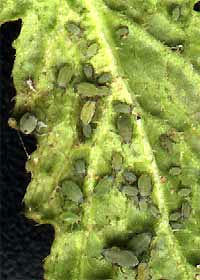Excerpts from Jim Conrad's
Naturalist Newsletter
from the January 13, 2002 Newsletter, issued from near Natchez, Mississippi:
TURNIP APHIDS
 Last week I mentioned that that Thursday's 14° weather had not fazed the aphids on my turnips. You can see the aphid-covered bottom of an immature turnip leaf from one of my gardens at the right.
Last week I mentioned that that Thursday's 14° weather had not fazed the aphids on my turnips. You can see the aphid-covered bottom of an immature turnip leaf from one of my gardens at the right.
This week I have been studying my aphids and I find them pretty interesting creatures. First of all, there are many kinds of aphids, and each species has its own special life cycle. The one on my turnips is the Turnip Aphid, LIPAPHIS ERYSIMI. A typical aphid life cycle goes approximately like this:
A wingless female hatches from an egg and begins sucking juice from its host plant. Without assistance from a male, this female -- instead of laying eggs -- gives birth to a number of wingless females like herself. Wingless virgin females then produce generation after generation of wingless virgin females. About when summer comes along certain of them begin producing offspring that develop wings, and this new generation of winged aphids then flies to a new plant, which may be a completely different species from the host plant of their mothers.
On this second host plant, new generations of mostly wingless females are born. As colder weather begins coming along in late fall, suddenly a generation of winged aphids is produced and now about half of them are males. Sexual reproduction takes place the usual way and the female returns to the kind of host plant we started with in the spring, and lays eggs on it. These eggs overwinter and next spring the cycle begins again.
The life cycle of my Turnip Aphids differs from the above scenario. Since Turnip Aphids live mostly where winters are not severe, the overwintering egg stage is basically skipped. As my January turnip leaf shows, the females just keep producing females all year round, and both eggs and males are usually very hard or impossible to find.
Turnip Aphids do often switch host-plant types, though the new host species must be a member of the Mustard Family, such as radishes, kale, collards, and weeds such as Bitter Cress and Shepherdspurse. In places where Canola, or rape seed, is grown, our species has become a serious pest.
The ability of aphids to reproduce is mind-boggling. Wingless adult females can produce 50 to 100 offspring. A newly born aphid becomes a reproducing adult within about a week and then can produce up to 5 offspring per day for up to 30 days! The French naturalist Reaumur during the late eighteenth century calculated that if all the descendants of a single aphid survived during the summer and were arranged into a French military formation, four abreast, their line would extend for 27,950 miles, which exceeds the circumference of the Earth at the Equator!